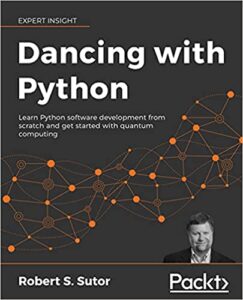
My new book Dancing with Python: Learn Python software development from scratch and get started with quantum computing is now available for purchase from Amazon and Packt Publishing.
Develop skills in Python by implementing exciting algorithms, including mathematical functions, classical searching, data analysis, plotting data, machine learning techniques, and quantum circuits.
Key Features
Learn Python basics to write elegant and efficient code
Create quantum circuits and algorithms using Qiskit and run them on quantum computing hardware and simulators
Delve into Python’s advanced features, including machine learning, analyzing data, and searching
Contributors
About the author
About the reviewer
Contents
List of Figures
Preface
Why did I write this book?
For whom did I write this book?
What does this book cover?
What conventions do I use in this book?
Get in touch
1 Doing the Things That Coders Do
1.1 Data
1.2 Expressions
1.3 Functions
1.4 Libraries
1.5 Collections
1.6 Conditional processing
1.7 Loops
1.8 Exceptions
1.9 Records
10 Contents
1.10 Objects and classes
1.11 Qubits
1.12 Circuits
1.13 Summary
I Getting to Know Python
2 Working with Expressions
2.1 Numbers
2.2 Strings
2.3 Lists
2.4 Variables and assignment
2.5 True and False
2.6 Arithmetic
2.7 String operations
2.8 List operations
2.9 Printing
2.10 Conditionals
2.11 Loops
2.12 Functions
2.13 Summary
3 Collecting Things Together
3.1 The big three
3.2 Lists
3.3 The joy of O(1)
3.4 Tuples
3.5 Comprehensions
3.6 What does “Pythonic” mean?
3.7 Nested comprehensions
3.8 Parallel traverse
3.9 Dictionaries
3.10 Sets
3.11 Summary
4 Stringing You Along
4.1 Single, double, and triple quotes
4.2 Testing for substrings
4.3 Accessing characters
4.4 Creating strings
4.5 Strings and iterations
4.6 Strings and slicing
4.7 String tests
4.8 Splitting and stripping
4.9 Summary
5 Computing and Calculating
5.1 Using Python modules
5.2 Integers
5.3 Floating-point numbers
5.4 Rational numbers
5.5 Complex numbers
5.6 Symbolic computation
5.7 Random numbers
5.8 Quantum randomness
5.9 Summary
6 Defining and Using Functions
6.1 The basic form
6.2 Parameters and arguments
6.3 Naming conventions
6.4 Return values
6.5 Keyword arguments
6.6 Default argument values
6.7 Formatting conventions
6.8 Nested functions
6.9 Variable scope
6.10 Functions are objects
6.11 Anonymous functions
6.12 Recursion
6.13 Summary
7 Organizing Objects into Classes
7.1 Objects
7.2 Classes, methods, and variables
7.3 Object representation
7.4 Magic methods
7.5 Attributes and properties
7.6 Naming conventions and encapsulation
7.7 Commenting Python code
7.8 Documenting Python code
7.9 Enumerations
7.10 More polynomial magic
7.11 Class variables
7.12 Class and static methods
7.13 Inheritance
7.14 Iterators
7.15 Generators
7.16 Objects in collections
7.17 Creating modules
7.18 Summary
8 Working with Files
8.1 Paths and the file system
8.2 Moving around the file system
8.3 Creating and removing directories
8.4 Lists of files and folders
8.5 Names and locations
8.6 Types of files
8.7 Reading and writing files
8.8 Saving and restoring data
8.9 Summary
II Algorithms and Circuits
9 Understanding Gates and Circuits
9.1 The software stack
9.2 Boolean operations and bit logic gates
9.3 Logic circuits
9.4 Simplifying bit expressions
9.5 Universality for bit gates
9.6 Quantum gates and operations
9.7 Quantum circuits
9.8 Universality for quantum gates
9.9 Summary
10 Optimizing and Testing Your Code
10.1 Testing your code
10.2 Timing how long your code takes to run
10.3 Optimizing your code
10.4 Looking for orphan code
10.5 Defining and using decorators
10.6 Summary
11 Searching for the Quantum Improvement
11.1 Classical searching
11.2 Quantum searching via Grover
11.3 Oracles
11.4 Inversion about the mean
11.5 Amplitude amplification
11.6 Searching over two qubits
11.7 Summary
III Advanced Features and Libraries
12 Searching and Changing Text
12.1 Core string search and replace methods
12.2 Regular expressions
12.3 Introduction to Natural Language Processing
12.4 Summary
13 Creating Plots and Charts
13.1 Function plots
13.2 Bar charts
13.3 Histograms
13.4 Pie charts
13.5 Scatter plots
13.6 Moving to three dimensions
13.7 Summary
14 Analyzing Data
14.1 Statistics
14.2 Cats and commas
14.3 pandas DataFrames
14.4 Data cleaning
14.5 Statistics with pandas
14.6 Converting categorical data
14.7 Cats by gender in each locality
14.8 Are all tortoiseshell cats female?
14.9 Cats in trees and circles
14.10 Summary
15 Learning, Briefly
15.1 What is machine learning?
15.2 Cats again
15.3 Feature scaling
15.4 Feature selection and reduction
15.5 Clustering
15.6 Classification
15.7 Linear regression
15.8 Concepts of neural networks
15.9 Quantum machine learning
15.10 Summary
Appendices
A Tools
A.1 The operating system command line
A.2 Installing Python
A.3 Installing Python modules and packages
A.4 Installing a virtual environment
A.5 Installing the Python packages used in this book
A.6 The Python interpreter
A.7 IDLE
A.8 Visual Studio Code
A.9 Jupyter notebooks
A.10 Installing and setting up Qiskit
A.11 The IBM Quantum Composer and Lab
A.12 Linting
B Staying Current
B.1 python.org
B.2 qiskit.org
B.3 Python expert sites
B.4 Asking questions and getting answers
C The Complete UniPoly Class
D The Complete Guitar Class Hierarchy
E Notices
E.1 Photos, images, and diagrams
E.2 Data
E.3 Trademarks
E.4 Python 3 license
F Production Notes
References
Other Books You May Enjoy
Index
Index Formatting Examples
Python function, method, and property index
Python class index
Python module and package index
General index

